初三英语讲义寒假班八动词时态
动词八种时态详解
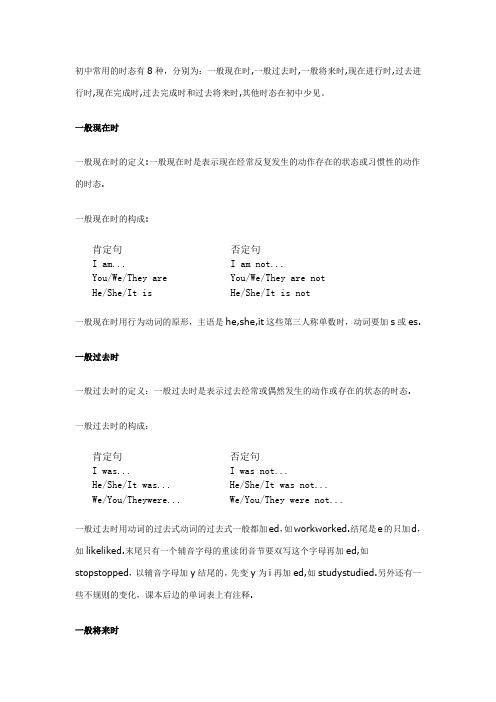
初中常用的时态有8种,分别为:一般现在时,一般过去时,一般将来时,现在进行时,过去进行时,现在完成时,过去完成时和过去将来时,其他时态在初中少见。
一般现在时一般现在时的定义:一般现在时是表示现在经常反复发生的动作存在的状态或习惯性的动作的时态.一般现在时的构成:肯定句否定句I am... I am not...You/We/They are You/We/They are notHe/She/It is He/She/It is not一般现在时用行为动词的原形,主语是he,she,it这些第三人称单数时,动词要加s或es.一般过去时一般过去时的定义:一般过去时是表示过去经常或偶然发生的动作或存在的状态的时态.一般过去时的构成:肯定句否定句I was... I was not...He/She/It was... He/She/It was not...We/You/Theywere... We/You/They were not...一般过去时用动词的过去式动词的过去式一般都加ed,如workworked.结尾是e的只加d,如likeliked.末尾只有一个辅音字母的重读闭音节要双写这个字母再加ed,如stopstopped,以辅音字母加y结尾的,先变y为i再加ed,如studystudied.另外还有一些不规则的变化,课本后边的单词表上有注释.一般将来时一般将来时的定义:一般将来时是表示将来发生的动作或存在的状态的时态.一般将来时的构成:肯定句否定句I/We will go. I/We will not go.You will go. You will not go.He/She/It/They will go. He/She/They will not go.一般将来时由助动词(will,shall)+动词原形构成,shall主要用于以第一人称(I,We)为主语的疑问句中.现在进行时现在进行时的定义:现在进行时是表示在某一时刻或某段时间正在进行的动作的时态.现在进行时的构成:现在进行时由系动词(am,is,are)+现在分词(动词加ing形式)构成.如:肯定句:I am working.疑问句:Am I working?否定句:I am not working.。
中考英语专题 --八种常见动词时态讲解(共49张PPT)

二、一般过去时
1.一般过去时的结构:
主语+动词过去式+其它
I did my homework yesterday.
(did就是do的过去式) 否定构成:didn’t+动原 一般疑问构成及简答举例:Did+主语+动原+其它? 特殊疑问句举例:What did he do yesterday? When did he get up this morning?
火车明天上午六点开。
6)在复合句中,当主句是一般将来时,时间状语 从句或条件状语从句的谓语动词只能用一般现在 时来表示将来。 例如: I'll tell him the news when he comes back. 他 回来时,我将告诉他这个消息。
If you take the job , they will talk with you in greater details. 如果你接受这份工作,他们将和你谈谈细节。
I do my homework every day.
1.改为一般疑问句并回答。 Do you do your homework every day? Yes, I do./No, I don't. 2.改为否定句。 I don't do my homework every day.
Jim does his homework every day. 1.改为一般疑问句并回答。 Does Jim do his homework every day? Yes, he does./No, he doesn't. 2.改为否定句。 Jim doesn't do his homework every day.
初中英语八大时态归纳总结
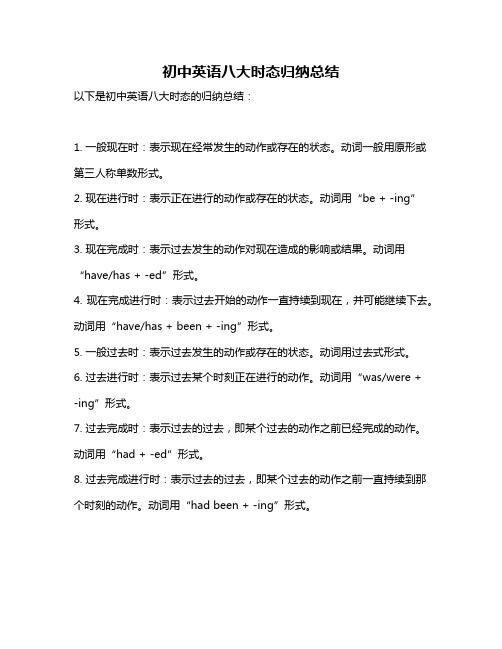
初中英语八大时态归纳总结
以下是初中英语八大时态的归纳总结:
1. 一般现在时:表示现在经常发生的动作或存在的状态。
动词一般用原形或第三人称单数形式。
2. 现在进行时:表示正在进行的动作或存在的状态。
动词用“be + -ing”
形式。
3. 现在完成时:表示过去发生的动作对现在造成的影响或结果。
动词用“have/has + -ed”形式。
4. 现在完成进行时:表示过去开始的动作一直持续到现在,并可能继续下去。
动词用“have/has + been + -ing”形式。
5. 一般过去时:表示过去发生的动作或存在的状态。
动词用过去式形式。
6. 过去进行时:表示过去某个时刻正在进行的动作。
动词用“was/were + -ing”形式。
7. 过去完成时:表示过去的过去,即某个过去的动作之前已经完成的动作。
动词用“had + -ed”形式。
8. 过去完成进行时:表示过去的过去,即某个过去的动作之前一直持续到那个时刻的动作。
动词用“had been + -ing”形式。
以上是初中英语的八大时态,理解和掌握这些时态对于英语学习和交流非常重要。
八大时态用法及详解
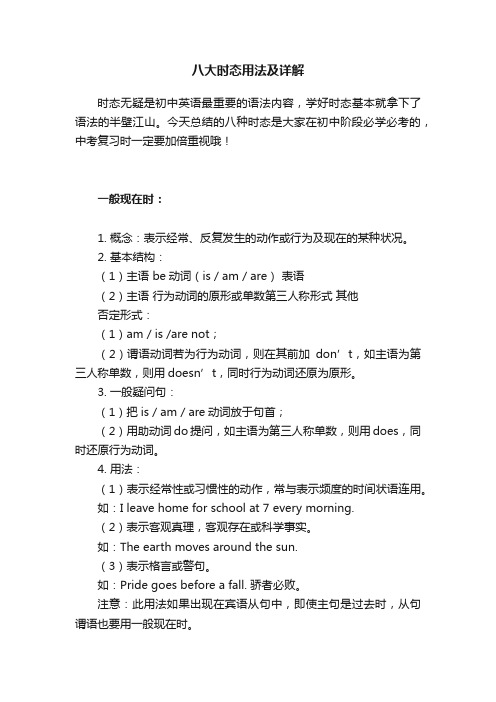
八大时态用法及详解时态无疑是初中英语最重要的语法内容,学好时态基本就拿下了语法的半壁江山。
今天总结的八种时态是大家在初中阶段必学必考的,中考复习时一定要加倍重视哦!一般现在时:1. 概念:表示经常、反复发生的动作或行为及现在的某种状况。
2. 基本结构:(1)主语 be动词(is / am / are)表语(2)主语行为动词的原形或单数第三人称形式其他否定形式:(1)am / is /are not;(2)谓语动词若为行为动词,则在其前加don’t,如主语为第三人称单数,则用doesn’t,同时行为动词还原为原形。
3. 一般疑问句:(1)把is / am / are动词放于句首;(2)用助动词do提问,如主语为第三人称单数,则用does,同时还原行为动词。
4. 用法:(1)表示经常性或习惯性的动作,常与表示频度的时间状语连用。
如:I leave home for school at 7 every morning.(2)表示客观真理,客观存在或科学事实。
如:The earth moves around the sun.(3)表示格言或警句。
如:Pride goes before a fall. 骄者必败。
注意:此用法如果出现在宾语从句中,即使主句是过去时,从句谓语也要用一般现在时。
如:Columbus proved that the earth is round.(4)表示现在时刻的状态、能力、性格、个性等。
如:I don’t want so much.Ann writes good English but does not speak well.(5)一般现在时表示将来含义① come, go, arrive, leave, start, begin, return的一般现在时可以表示将来,主要用来表示在时间上已确定或安排好的事情。
如:The train leaves at six tomorrow morning.— When does the bus star?— It stars in ten minutes.② 在时间或条件状语句中。
初中英语动词八种时态讲解(推荐阅读)
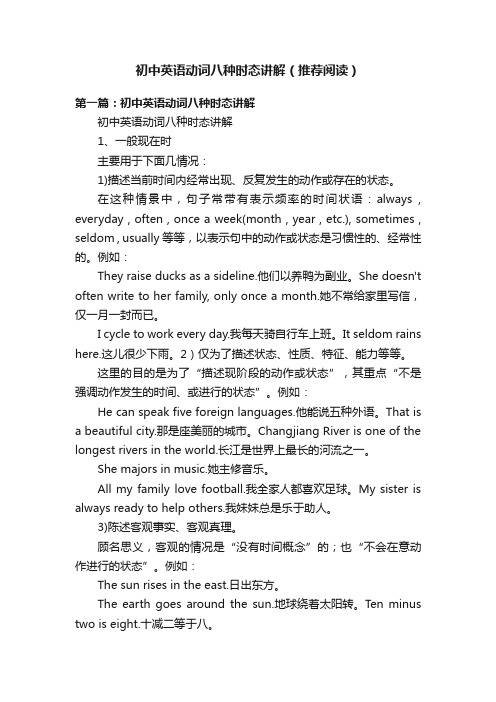
初中英语动词八种时态讲解(推荐阅读)第一篇:初中英语动词八种时态讲解初中英语动词八种时态讲解1、一般现在时主要用于下面几情况:1)描述当前时间内经常出现、反复发生的动作或存在的状态。
在这种情景中,句子常带有表示频率的时间状语:always , everyday , often , once a week(month , year , etc.), sometimes , seldom , usually等等,以表示句中的动作或状态是习惯性的、经常性的。
例如:They raise ducks as a sideline.他们以养鸭为副业。
She doesn't often write to her family, only once a month.她不常给家里写信,仅一月一封而已。
I cycle to work every day.我每天骑自行车上班。
It seldom rains here.这儿很少下雨。
2)仅为了描述状态、性质、特征、能力等等。
这里的目的是为了“描述现阶段的动作或状态”,其重点“不是强调动作发生的时间、或进行的状态”。
例如:He can speak five foreign languages.他能说五种外语。
That is a beautiful city.那是座美丽的城市。
Changjiang River is one of the longest rivers in the world.长江是世界上最长的河流之一。
She majors in music.她主修音乐。
All my family love football.我全家人都喜欢足球。
My sister is always ready to help others.我妹妹总是乐于助人。
3)陈述客观事实、客观真理。
顾名思义,客观的情况是“没有时间概念”的;也“不会在意动作进行的状态”。
例如:The sun rises in the east.日出东方。
初三动词的时态和语态讲义
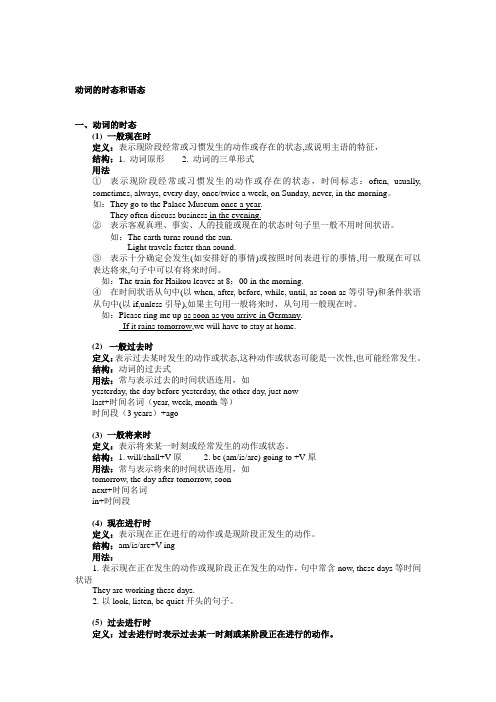
动词的时态和语态一、动词的时态(1)一般现在时定义:表示现阶段经常或习惯发生的动作或存在的状态,或说明主语的特征,结构:1. 动词原形 2. 动词的三单形式用法①表示现阶段经常或习惯发生的动作或存在的状态,时间标志:often, usually,sometimes, always, every day, once/twice a week, on Sunday, never, in the morning。
如:They go to the Palace Museum once a year.They often discuss business in the evening.②表示客观真理、事实、人的技能或现在的状态时句子里一般不用时间状语。
如:The earth turns round the sun.Light travels faster than sound.③表示十分确定会发生(如安排好的事情)或按照时间表进行的事情,用一般现在可以表达将来,句子中可以有将来时间。
如:The train for Haikou leaves at 8:00 in the morning.④在时间状语从句中(以when, after, before, while, until, as soon as等引导)和条件状语从句中(以if,unless引导),如果主句用一般将来时,从句用一般现在时。
如:Please ring me up as soon as you arrive in Germany.If it rains tomorrow,we will have to stay at home.(2)一般过去时定义:表示过去某时发生的动作或状态,这种动作或状态可能是一次性,也可能经常发生。
结构:动词的过去式用法:常与表示过去的时间状语连用,如yesterday, the day before yesterday, the other day, just nowlast+时间名词(year, week, month等)时间段(3 years)+ago(3)一般将来时定义:表示将来某一时刻或经常发生的动作或状态。
初中英语八大时态讲解及练习讲义(一)

8月4课题初中英语时态复习(一)Step one. Check & review1.复习上节课内容(梳理上节课情态动词的重难点和易错点)2.检查上节课作业,并讲解Step Two 时态概述时态(Tense)是表示行为、动作和状态在各种时间条件下的动词形式。
英语时态分为16种:一般现在、一般过去、一般将来、过去将来时,以及这四者的进行时、完成时和完成进行时。
在初中阶段要求掌握以下8大时态。
初中英语必考八大时态基本结构Step Three.一般现在时一.一般现在时的动词形式-----do∕does(要注意,主语是第三人称时,谓语动词要用第三人称单数形式)二.一般现在时一般用法(1).经常性或习惯性的动作,常与表示频度的时间状语连用。
时间状语:every…, sometimes, at…, on Sunday。
Eg. I _(leave)home for school at 7 every morning.(2)..现在时刻的状态,能力,性格,个性。
Ann Wang (write)good English but does not speak well.(3).客观真理,客观存在,科学事实,名言警句。
Eg. Columbus proved that the earth _round.A. are B is C was D were三.一般现在时表将来(新内容,注意!!!考点)e, go, arrive, leave, start, begin, return的一般现在时可以表示将来,主要用来表示在时间上已确定或安排好的事情。
When does the bus star? It (start) in ten minutes.2. 在时间或条件句中I'll write to you as soon as I_(arrive) there.Step Four .一般过去时一般过去时表示过去某个时间里发生的动作或存在状态.一.一般过去时的动词形式---did二.一般过去时一般用法1.在确定的过去时间里所发生的动作或存在的状态。
初三动词时态讲解
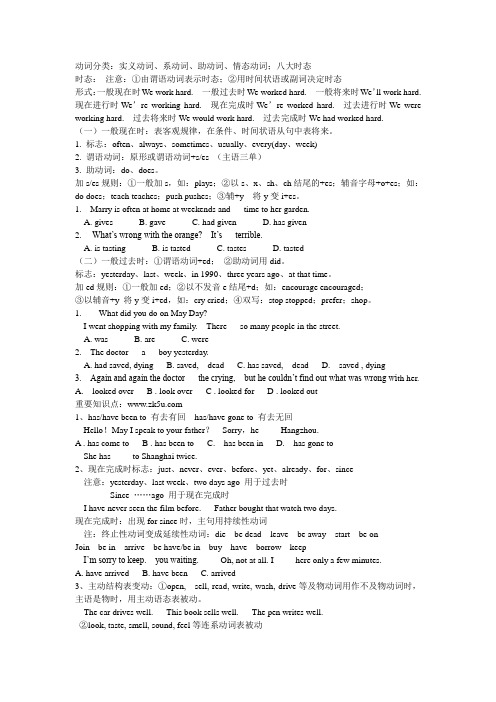
动词分类:实义动词、系动词、助动词、情态动词;八大时态时态:注意:①由谓语动词表示时态;②用时间状语或副词决定时态形式:一般现在时We work hard. 一般过去时We worked hard. 一般将来时We’ll work hard. 现在进行时We’re working hard. 现在完成时We’re worked hard. 过去进行时We were working hard. 过去将来时We would work hard. 过去完成时We had worked hard.(一)一般现在时:表客观规律,在条件、时间状语从句中表将来。
1. 标志:often、always、sometimes、usually、every(day、week)2. 谓语动词:原形或谓语动词+s/es (主语三单)3. 助动词:do、does。
加s/es规则:①一般加s,如:plays;②以s、x、sh、ch结尾的+es;辅音字母+o+es;如:do does;teach teaches;push pushes;③辅+y 将y变i+es。
1. Marry is often at home at weekends and time to her garden.A. givesB. gaveC. had givenD. has given2. ---What’s wrong with the orange?---It’s terrible.A. is tastingB. is tastedC. tastesD. tasted(二)一般过去时:①谓语动词+ed;②助动词用did。
标志:yesterday、last、week、in 1990、three years ago、at that time。
加ed规则:①一般加ed;②以不发音e结尾+d;如:encourage encouraged;③以辅音+y 将y变i+ed,如:cry cried;④双写:stop stopped;prefer;shop。
九年级英语语法总复习之动词时态
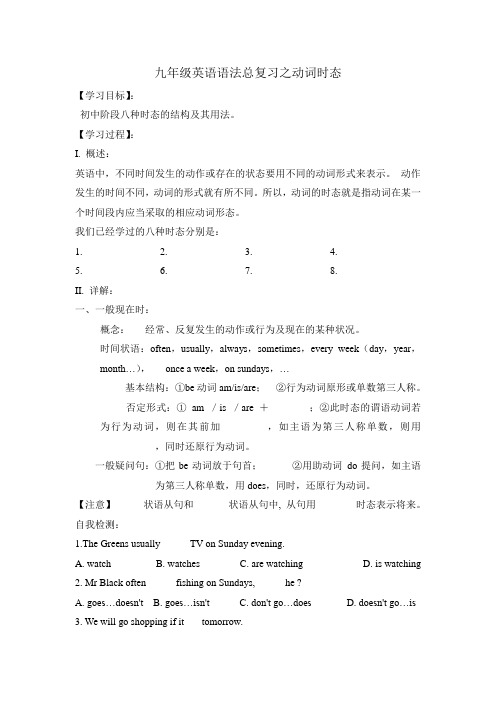
九年级英语语法总复习之动词时态【学习目标】:初中阶段八种时态的结构及其用法。
【学习过程】:I. 概述:英语中,不同时间发生的动作或存在的状态要用不同的动词形式来表示。
动作发生的时间不同,动词的形式就有所不同。
所以,动词的时态就是指动词在某一个时间段内应当采取的相应动词形态。
我们已经学过的八种时态分别是:1. _______________2. _______________3. _______________4._______________5. _______________6. _______________7. _______________8. _______________ II. 详解:一、一般现在时:概念:经常、反复发生的动作或行为及现在的某种状况。
时间状语:often,usually,always,sometimes,every week(day,year,month…),once a week,on sundays,…基本结构:①be动词am/is/are;②行为动词原形或单数第三人称。
否定形式:①am /is /are +________;②此时态的谓语动词若为行为动词,则在其前加_________,如主语为第三人称单数,则用___________,同时还原行为动词。
一般疑问句:①把be动词放于句首;②用助动词do提问,如主语为第三人称单数,用does,同时,还原行为动词。
【注意】______状语从句和_______状语从句中, 从句用________时态表示将来。
自我检测:1.The Greens usually _____ TV on Sunday evening.A. watchB. watchesC. are watchingD. is watching2. Mr Black often _____ fishing on Sundays, _____ he ?A. goes…doesn'tB. goes…isn'tC. don't go…doesD. doesn't go…is3. We will go shopping if it___ tomorrow.A don't rainB didn't rainC doesn't rainD isn't rain4. I will tell him as soon as he _____ backA. comeB. comesC. will comeD. came5. He said the sun ____in the east and ____in the west.A rose; setB rises; setsC rises, setD rise; sets二、一般过去时:概念:过去某个时间里发生的动作或状态;过去习惯性、经常性的动作、行为。
知识点初三动词时态总结
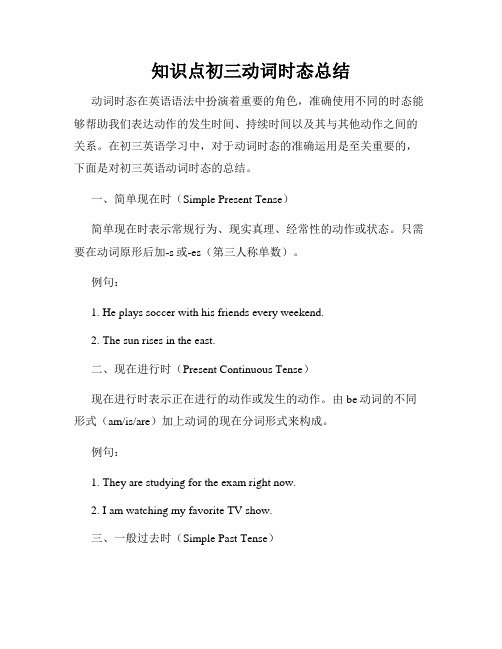
知识点初三动词时态总结动词时态在英语语法中扮演着重要的角色,准确使用不同的时态能够帮助我们表达动作的发生时间、持续时间以及其与其他动作之间的关系。
在初三英语学习中,对于动词时态的准确运用是至关重要的,下面是对初三英语动词时态的总结。
一、简单现在时(Simple Present Tense)简单现在时表示常规行为、现实真理、经常性的动作或状态。
只需要在动词原形后加-s或-es(第三人称单数)。
例句:1. He plays soccer with his friends every weekend.2. The sun rises in the east.二、现在进行时(Present Continuous Tense)现在进行时表示正在进行的动作或发生的动作。
由be动词的不同形式(am/is/are)加上动词的现在分词形式来构成。
例句:1. They are studying for the exam right now.2. I am watching my favorite TV show.三、一般过去时(Simple Past Tense)一般过去时表示已经发生、完成的动作或状态。
动词的过去式形式通常是在动词原形后加-ed,也有些动词的变化规则不规律。
例句:1. We went to the beach last summer.2. She played basketball after school.四、过去进行时(Past Continuous Tense)过去进行时表示过去某一时间点正在进行的动作。
由be动词的过去式形式(was/were)加上动词的现在分词形式来构成。
例句:1. They were studying in the library yesterday.2. I was cooking dinner when the phone rang.五、一般将来时(Simple Future Tense)一般将来时表示将来某个时间发生或存在的动作或状态。
中考英语语法动词的时态复习讲义及总结与整理
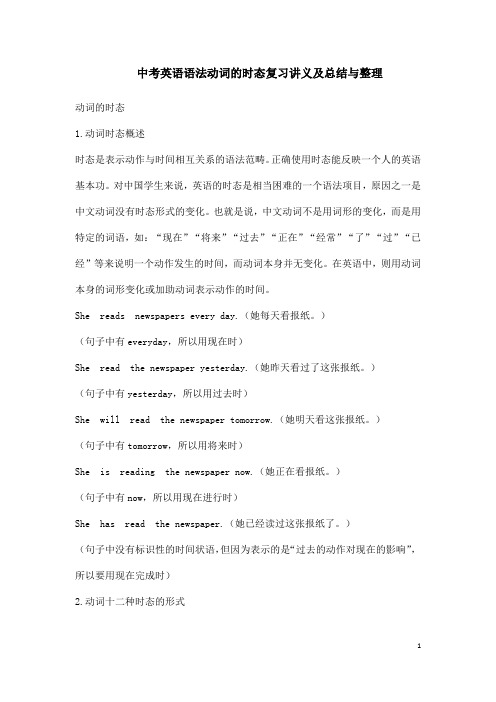
中考英语语法动词的时态复习讲义及总结与整理动词的时态1.动词时态概述时态是表示动作与时间相互关系的语法范畴。
正确使用时态能反映一个人的英语基本功。
对中国学生来说,英语的时态是相当困难的一个语法项目,原因之一是中文动词没有时态形式的变化。
也就是说,中文动词不是用词形的变化,而是用特定的词语,如:“现在”“将来”“过去”“正在”“经常”“了”“过”“已经”等来说明一个动作发生的时间,而动词本身并无变化。
在英语中,则用动词本身的词形变化或加助动词表示动作的时间。
She reads newspapers every day.(她每天看报纸。
)(句子中有everyday,所以用现在时)She read the newspaper yesterday.(她昨天看过了这张报纸。
)(句子中有yesterday,所以用过去时)She will read the newspaper tomorrow.(她明天看这张报纸。
)(句子中有tomorrow,所以用将来时)She is reading the newspaper now.(她正在看报纸。
)(句子中有now,所以用现在进行时)She has read the newspaper.(她已经读过这张报纸了。
)(句子中没有标识性的时间状语,但因为表示的是“过去的动作对现在的影响”,所以要用现在完成时)2.动词十二种时态的形式英语动词共有十六种时态,一般语法书列出的英语动词的十二种时态为“现在”“过去”和“将来”三大类;每类中又分为“一般”“进行”“完成”“完成进行”四种,共十二种,下面以study为例,列表说明。
注意:初中阶段最常用的时态有5种,即一般现在时、一般过去时、现在进行时、一般将来时和现在完成时。
在下面的文章中,将分别讲述各种时态的具体用法。
不规则动词变化表例题:( )1. —When did you meet him? —While I ____ on the street.A. walksB. walkC. was walkingD. am walking( )2. —Mum, why don't you go to sleep? —Your sister ____ yet. I ____ for her.A. hasn't come back; am waitingB. didn't come back; was waitingC. hadn't come back; was waitingD. came back; waited( )3. —King White ___ in our company for 20 years.—Yes, and she ___ here when she was 21 years old.A. has worked; has comeB. worked; comesC. worked; cameD. has worked; came( )4. —Don't forget to visit me when you come here.—OK. I ___ you a call as soon as I ____ there.A. gave; getB. will give; will getC. give; will getD. will give; get( )5. —What did you do last summer vacation?—Don't mention it. I ____ always ____ my parents on the farm.A. was; helpingB. / ; helpedC. would; helpD. have; helped( )6. —Would you like to see the movie? —No, thanks.I ____ it twice.A. have seenB. seenC. sawD. had seen( )7. —Are you still single? —No, I ____ for two months.A. have been marriedB. have marriedC. was marryingD. married( )8. —We will do some cleaning if the weather ___ fine tomorrow.—But I think it ____ rain.A. will be; is going toB. is; is going toC. is; hasD. will be; has( )9. —Mike is preparing his luggage. —Yes. He _____ for Canada on vacation.A. leavesB. leftC. is leavingD. has been away( )10. —Be quiet. Dad ___ in the next room. —Sorry.A. sleepsB. sleptC. is sleepingD. was sleeping参考答案:1-5 CADDA 6-10 AABCC。
初中英语8个动词时态时间轴、时态结构搭配图、时态简表、时态复习讲义
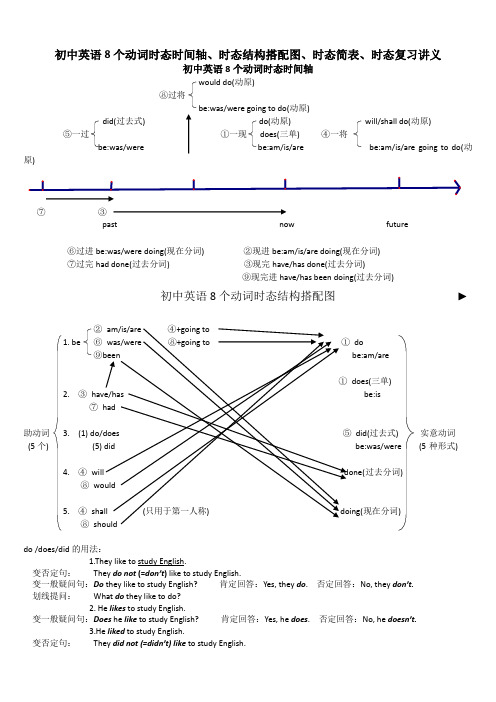
初中英语8个动词时态时间轴、时态结构搭配图、时态简表、时态复习讲义初中英语8个动词时态时间轴would do(动原)⑧过将be:was/were going to do(动原)did(过去式) do(动原) will/shall do(动原)⑤一过①一现does(三单) ④一将be:was/were be:am/is/are be:am/is/are going to do(动原)⑦③past now future⑥过进be:was/were doing(现在分词) ②现进be:am/is/are doing(现在分词)⑦过完had done(过去分词) ③现完have/has done(过去分词)⑨现完进have/has been doing(过去分词)初中英语8个动词时态结构搭配图②am/is/are ④+going to1. be ⑥was/were ⑧+going to ①do⑨been be:am/are①does(三单)2. ③have/has be:is⑦had助动词 3. (1) do/does ⑤did(过去式) 实意动词(5个) (5) did be:was/were (5种形式)4. ④will done(过去分词)⑧would5. ④shall (只用于第一人称) doing(现在分词)⑧shoulddo /does/did的用法:1.They like to study English.变否定句:They do not (=don’t) like to study English.变一般疑问句:Do they like to study English? 肯定回答:Yes, they do. 否定回答:No, they don’t.划线提问:What do they like to do?2. He likes to study English.变一般疑问句:Does he like to study English? 肯定回答:Yes, he does. 否定回答:No, he doesn’t.3.He liked to study English.变否定句:They did not (=didn’t) like to study English.初中英语8个动词时态简表(表格+图表)初中英语8个动词时态复习讲义一般现在时一、动词的第三人称词尾变化:写出下列动词的单数第三人称形式。
英语九年级第8单元知识点
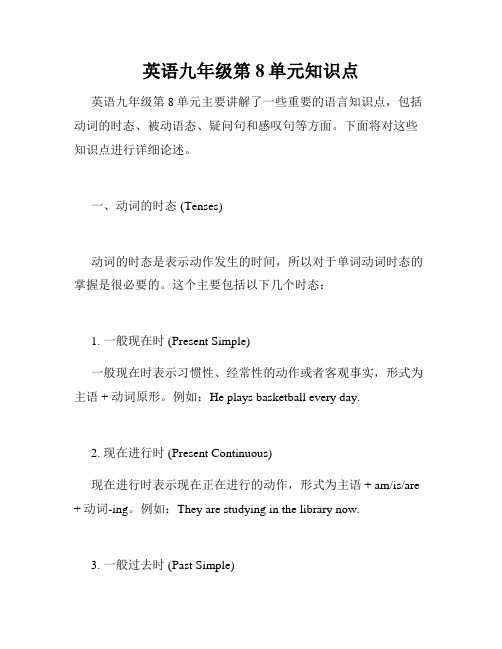
英语九年级第8单元知识点英语九年级第8单元主要讲解了一些重要的语言知识点,包括动词的时态、被动语态、疑问句和感叹句等方面。
下面将对这些知识点进行详细论述。
一、动词的时态 (Tenses)动词的时态是表示动作发生的时间,所以对于单词动词时态的掌握是很必要的。
这个主要包括以下几个时态:1. 一般现在时 (Present Simple)一般现在时表示习惯性、经常性的动作或者客观事实,形式为主语 + 动词原形。
例如:He plays basketball every day.2. 现在进行时 (Present Continuous)现在进行时表示现在正在进行的动作,形式为主语 + am/is/are + 动词-ing。
例如:They are studying in the library now.3. 一般过去时 (Past Simple)一般过去时表示过去某个时间发生的动作,形式为主语 + 动词过去式。
例如:She watched a movie last night.4. 过去进行时 (Past Continuous)过去进行时表示过去某个时间正在进行的动作,形式为主语 + was/were + 动词-ing。
例如:We were having dinner at 7 p.m. yesterday.5. 将来时 (Future Tense)将来时表示将来要发生的动作,形式为主语+ will + 动词原形。
例如:The train will arrive at 10 a.m. tomorrow.二、被动语态 (Passive Voice)被动语态表示动作的承受者重要于动作的执行者,形式为被动语态的结构:主语 + 被动助动词(am/is/are/was/were)+ 过去分词。
例如:The book was written by a famous author.被动语态的使用可以准确表达句子中的重点,尤其是在科学、新闻等文章中经常使用。
中考英语语法复习教案讲义第八讲:动词的时态
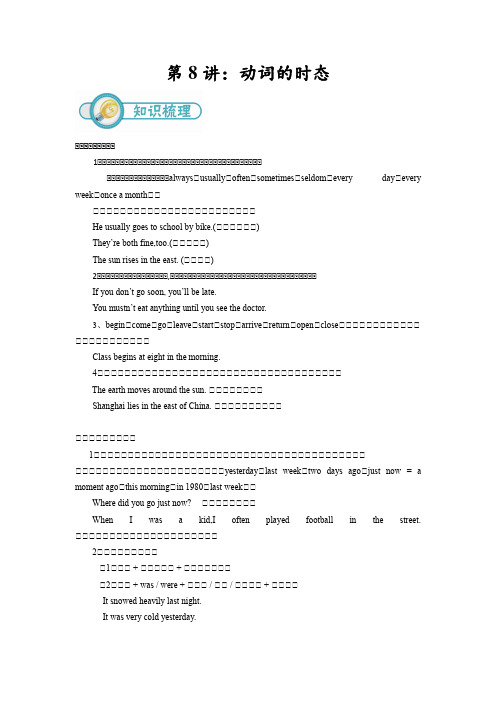
第8讲:动词的时态考考考考考考考考考1、、、、、、、、、、、、、、、、、、、、、、、、、、、、、、、、、、、、、、、、、、、、、、、、、、、always,usually,often,sometimes,seldom,every day,every week,once a month,,提提提,,,,,,,,,,,,,,,,,,,,,He usually goes to school by bike.(,,,,,,)They’re both fine,too.(,,,,,)The sun rises in the east. (,,,,)2、、、、、、、、、、、、、、、、,、、、、、、、、、、、、、、、、、、、、、、、、、、、、、、、、、If you don’t go soon, you’ll be late.You mustn’t eat anything until you see the doctor.3、begin,come,go,leave,start,stop,arrive,return,open,close,,,,,,,,,,,,,,,,,,,,,,,Class begins at eight in the morning.4,,,,,,,,,,,,,,,,,,,,,,,,,,,,,,,,,,,,The earth moves around the sun. ,,,,,,,,Shanghai lies in the east of China. ,,,,,,,,,,提提提提提提提提提1,,,,,,,,,,,,,,,,,,,,,,,,,,,,,,,,,,,,,,,,,,,,,,,,,,,,,,,,,,,,,,yesterday,last week,two days ago,just now = a moment ago,this morning,in 1980,last week,,Where did you go just now? ,,,,,,,,When I was a kid,I often played football in the street. ,,,,,,,,,,,,,,,,,,,,,2,,,,,,,,,,1,,, + ,,,,, + ,,,,,,,,2,,, + was / were + ,,, / ,, / ,,,, + ,,,,It snowed heavily last night.It was very cold yesterday.提提提提提提提提提1,概念:表示将要发生的动作或存在的状态及打算、计划或准备做某事。
九年级寒假第2讲——玩转中考8大时态S
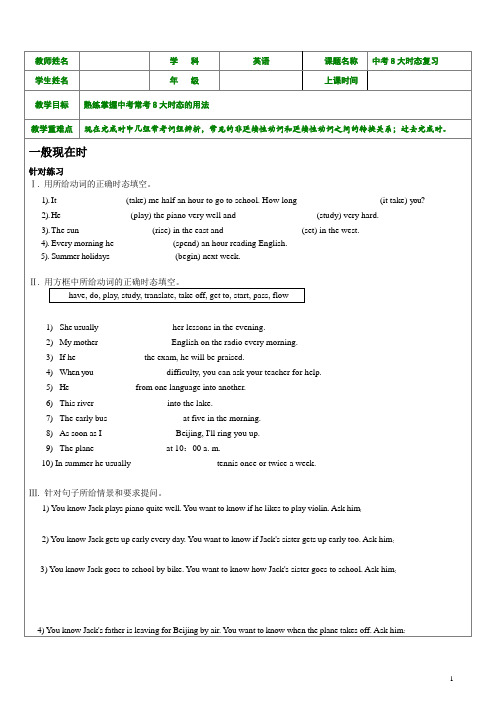
5) You know Jack plays table tennis. You want to know how often. Ask him:6) You don't know where Jack lives. Ask him:现在进行时针对练习1. 判别下列句子时态的正误,并将错误部分改正.1) Look! That thief tries to run away. ______________ ___________________________2) The moon goes round the sun. _____________ ___________________________3) There goes to be a heavy rain. _____________ ___________________________4) I take the kid to the zoo on Saturday. _____________ ___________________________5) The play begins at 7 p. m. _____________ ___________________________6) I must go now. It gets late. _____________ ___________________________7) Do you often wash your hair? _____________ ___________________________8) I fly to Hong Kong tomorrow. _____________ ___________________________2. 用所给动词的正确形式填空.1) They__________________ (live) in the same building, don't they?2) You must visit France when you __________________ (travel) in Europe.3) We usually ________________ (grow) vegetables in our garden but this year we_______________ (not grow) any.4)"Hurry up! It's time to leave. " "OK, I ___________________ . (come)"5)Jane ________________ (look) for a place to live. She ________________ (stay) with her sister until she findssomewhere.6) Jack is in Shanghai at the moment. He________________ (stay) at the Westin Hotel. He_______________(always stay) there when he's in Shanghai.3. 下面是两人的对话,用You're always+-ing 完成下列句子.1)A: I'm afraid I've lost my pen again. B: ________________________________2)A: Look! I've made the same mistake again. B: ________________________________3)A: Oh, sorry. I've left the lights on again. B: ________________________________4. 选择最佳答案填空.1) The supermarket is far from Mary's house. So she only once a week.A. goes shoppingB. has been thereC. was shoppingD. has gone there2) — How is Mike now?—D on't worry. He will call us as soon as he ___________________ the USA.A. getsB. reachesC. will getD. will reach3) Charlie can't go with us because he ___________________ a professor around our company.A. showsB. was showingC. has shownD. is showing4) — Is this your coat, sir?—N o. Mine ____________________ over there near the window.A. hangsB. is hangingC. hungD. has hung5) — __________________ to Japan?—Y es. And I will be back next month.A. Had you goneB. Have you beenC. Are you goingD. Did you go6) — Can your brother make model airplane?A. would; didn'tB. would; wouldn'tC. will; don'tD. will; won't现在完成时VS一般过去时针对练习1.用括号中所给动词的适当形式完成下列句子:1)"Where is your key?" "I don't know. I _________________ it. "(lose)2)I _____________ very tired, so I lay down on the bed and went to sleep. (be)3)"Where's Jack?" "He _________________ out. He'll be back in about an hour. "(go)4)Jack _______________ to Beijing for a visit but he is back now. (go)5)My father learned English at school but he_________________ most of it. (forget)6)I planned to phone you last night but I __________________ . (forget)7)The police ________________ three people but later they let them go. (arrest)8)They're still building the new road. They__________________ it. (not/finish)2. 选择最佳答案填空1) The Oriental Pearl TV Tower _______________ tens of thousands of visitors since 1995.A. attractedB. attractsC. has attractedD. will attract2) — How is your father? I_________________ him for a long time.—He is fine, but busy.A. don't seeB. hadn't seenC. didn't seeD. haven't seen3) Since 2000, Nanchang has become a new city. Everything _________________ .A. is changedB. was changedC. has changedD. had changed4) — I'm looking for Mr White.—He was here just now. But he ________________ t o a meeting and he won't be back until eleven o'clock.A. wasB. will beC. has goneD. has been5) — Hello, may I speak to your father, please?—S orry, my father ______________ to Shanghai. He went there this morning.A. goesB. has goneC. has beenD. go6) — Why won't Mr Wu go to Hainan with us?—B ecause he _______________ to Hongkong on business.A. have beenB. has beenC. have goneD. has gone7) I'm sorry you ______________ the last bus. It left ten minutes ago.A. have lostB. lostC. missedD. have missed8) — What are you going to do this weekend?—I_______________ yet.A. haven't decidedB. won't decideC. have decidedD. didn't decide9) Tom _____________ a lot of friends since he came to China last year.A. madeB. makesC. is makingD. has made10) — How clean the room is today!—O h, yes! Who _____________ it?A. is cleaningB. will cleanC. has cleanedD. had cleaned11) — I'm sorry to have kept you waiting.—O h, that's all right. I _______________ here for only a few minutes.A. have beenB. had beenC. wasD. will be12) — _________ you __________ a ticket for the football match?。
九年级英语专项讲义——动词时态

九年级英语专项讲义——动词时态基础知识讲解【动词时态】一、一般现在时概念:1. 经常性、习惯性的动作2.存在的状态3.客观真理标志词: always/ often/ usually/ sometimes/ seldom/ never/ every day/ twice a week等结构:一般情况用原形,当主语是第三人称单数,也就是非你非我非复数时,用三单。
动词变第三人称单数的规则:1. 一般直接加s2. 以o,s,x,ch,sh结尾的动词,加es3. 辅音字母加y结尾,变y为i加es4. 以不发音字母e结尾,直接加s特殊考点:if/unless引导的条件状语从句,遵循原则:主将从现二、一般过去时概念:1. 过去经常性、习惯性的动作2.过去存在的状态标志词:last...; ... ago; yesterday; just now; once upon a time等结构:动词过去式动词变过去式规则变化:(直去双改)1. 一般直接加ed2. 以不发音字母e结尾的动词,去e加ed3. 重读闭音节结尾,双写尾字母加ed4. 辅音字母加y结尾,变y为i加ed动词变过去式的不规则变化也需要根据人教版教材附录进行重点掌握。
三、一般将来时概念:在将来将要发生的事或状态。
标志词:next系列; tomorrow系列; in future; in the future结构(2种):will do和be going to do...只用will不用be going to的情况:不根据主观推测,一定会发生的事。
特殊考点:1. 现在进行表将来:短暂性动词,现在进行表将来,常见的有come/ arrive/ go/ leave/ begin/ start/ fly/ die。
2. 一般将来时和there be 句型的结合:There will be...或There is/ are going to be...3.be about to do sth.4.四、现在进行时概念:1. 此时此刻在做某事2. 最近的一段时间在做某事标志词:now/ right now/ at the moment/ at this moment/时间点以及look/ listen等情景标志词。
- 1、下载文档前请自行甄别文档内容的完整性,平台不提供额外的编辑、内容补充、找答案等附加服务。
- 2、"仅部分预览"的文档,不可在线预览部分如存在完整性等问题,可反馈申请退款(可完整预览的文档不适用该条件!)。
- 3、如文档侵犯您的权益,请联系客服反馈,我们会尽快为您处理(人工客服工作时间:9:00-18:30)。
中考英语寒假班讲义 (八)温馨提示: Hi,亲爱的同学,欢迎你参加2014年寒假班中考英语集训,祝你寒假愉快!1.请你务必认真听讲,积极总结系统语法点。
2.请你尽量在课堂上理解并记住所有考点,积极完成课堂练习并归纳解题技巧。
11 There is no point in doing 做某事毫无意义 12. as is known to all, +句子 众所周知 as we all know, +句子 据我们所知it is generally/ publicly known / considered that…,众所周知—It ’s about 4 kilometers _______. A. far B. long C. away D. near2. —Andy isn ’t going out this evening, is she?—_______. She has to stay at home to look after her sick mother.A. Yes, she isB. No, she isn ’tC. Yes, she isn ’tD. No, she is3. A spaceship flies at about eleven kilometers _______ second.A. /B. theC. aD. an4. There are a lot _______ people today than yesterday. A. of B. / C. most D. more5. “Excuse me, are you _______? ” “No, we are _______. ”A. American, EnglishmanB. American, GermansC. American, GermenD. Englishman, Americans中考英语复习系列讲练 —— 动 词 时 态中考对动词时态考查的知识要求:1动词现时称单数过过词现、掌握的在第三人、去式、去分和在词种分四形式的构规则成;2动词种时态、掌握六的结构基本区别现,主要用法及(一般在时过时将来时过进时现进时现、一般去、一般、去行、在行和在时完成)3过将来时过时态、了解去、去完成的基本用法;4、掌握动词助be, do, have, shall, will 的基本用法; 时态一、确定正确的1.时间状语时态根据确定.时间状语与时态有关着密切的系.a. I _____ (write) now.b. I ___(lose) my pen yesterday.c. We ___________ (study) English for two years.2.来时态根据上下文确定没显时间状语有些句子有明的,时态应规则来对又不能用呼照,这时内来断时间关就可以根据上下文容判系,时态确定正确. A.Where are the twins?B.They ______ (go) to visit Uncle Wang.3.从关来时态根据主句的系确定.4.语习惯来时态根据言确定*e,go,leave 趋动词进时来将等向性的行可用表示即发动生的作.*2.真观状态现时永恒的理和客存在的用一般在.*3.祈使句中,态动词或在情,动词助后,谓语动词用原形 Don't _____ (read)in the sun , will you?You'd better __ (stay)at home since it's raining outside. 填动词注意所的语态Today both basketball and volleyball _________(play) in many countries. 动词时态二、的(上)A:现时一般在用法: 1.实表示事,现状,质经性或常的,习惯动的作,与常often, usually, always, sometimes, today,every day,once a week, every five minutes, on Sundays 时间状语连等用, eg. He has a brother.2.真表示普遍理. eg. The earth goes round the sun.注意:a. 在间语接引转观真规中,如果述的是客理,一般律,谚语语现时时态变俗,一般在保持不。
例如:He said the earth is round. b. if 导条状语从现时将来引的件句中用一般在表示况的情;但if 为时导宾语从将作“是否”意思,其引的句如果表示来况则将来时的情用一般。
When 为当时导状语从作“、、候”,引时从现时将来况句,句用一般在表示的情,如:When he comes, I will let you know 导宾语从么时;如果引的是句,表示“什候”,则将来况将来时的情仍然用一般,如:I don’t know when he will visit me. c. 一些时间词副如seldom, usually, sometimes, often, never, every day 既过时等可以用于去,也可以用于一般现时区在。
要注意分。
例如:He often goes swimming. / He often went swimming in 1999. B:过时一般去用法 :1.过个时间发动状态主要用于去某生的作或. eg.My father was at work yesterday.2.过经复发动表示去常或反生的作,与常often,always 等表频时间状语连示度的用.eg.He always went to work by bus last summer.3.和when 连词导状语从连等引的句用. eg.When she reached home, she had a short rest.4.与过时间状语常表示去的, 如… ago, yesterday, last week, in the old days, when I was five years old, in 1995 连等用. eg.They began the work two months ago.[注意] 区过时过进时过时过发分一般去和去行。
一般去表示去侧结过进时过时间进生的事情,重果;而去行只表示去某段正在动结行的作,而不涉及果。
例如:He was writing a letter last night.写(不知道是否完了) / He wrote a letter last night. (结写果完了) C:将来时一般将来发动状态表示生的作或存在的结构: 动词助shall/will + 动词当语称时原形(主第一人,一般用shall 当语为称时,主第三人,用will 语为称,但主第一人时,也用will用法: 1.将发动表示要生的 况作或情,时间状语常用有: later (on), soon, in a month, next time, from now on, tomorrow 等. eg. I shall be eighteen years old next year. 2.种趋势表示某必然的 eg. Fish will die without water. 解析: 1.称为语问在以第一人主的句中,常用 shall 议表示提询问况和情,称语问在以第二人作主的句中,用will 请表示求. eg. Where shall we have the meeting? Will you please lend me your pen?2.当语称时主是第一人,用will 表示意愿.决心.诺允.命令等. eg. I will give you an English--Chinese dictionary for your birthday.3.时间条状语从在或件句中,现时将来一般用一般在代替一般时. eg. Tom will write to me when he gets there.4.be going to +动词将来时原形也可表示.(1).观表示主意愿.打算等. eg. He's going to learn English next term.(2).根据已有迹象,发况可能要生的情 eg. Look at the black clouds! ----It is going to rain. D:现进时在行用法: 1.发表示目前生(进行)动的作(状态不指),时间状语常用有:now,at the moment 等,并现常出在祈使句的句子中,与 look, listen 连用.eg. Are you writing a letter to your father at the moment? 2.计划将进动表示按或安排即行的作,这种动动词表示作的有:come, go, leave, arrive, start, see 等,并与将来时常表示间状语连的用. eg. They are leaving for Australia tomorrowafternoon. 注意: 觉状态动词某些表示感或的,如 love, like, prefer, hate, see, know 现进时等一般不用在行. eg. Lucy prefers art to science. G:现时在完成 为经并对现种响动表到目前止已完成,在留下某后果和影的作。
结构动词:助have/has + 动词过词的去分 用法: 1.过发动对现响结表示去生的某一作在造成的影或果,与常一些时间状语,如:already, yet, ever, never, just, before,once,twice 连等用,现内时间状语也可以和包括在在的,如these days,today,this year,so far 连等用.eg.I have already posted the letter. (经这儿信已不在我了) 2.过发动状态表示去生的作或存在的,续现一直持到在,许还也将继续下去,从过时续现时可以和表示去某一刻延到在的一段间状语连的用,即for +时间段,since+时间点/从句, in the last ten years 等,谓语续动词只可用延性. eg. I've left Shanghai for three days.(×) I've been away from Shanghai for three days.( √ ). I left Shanghai three days ago. ( √ ) It is /has been three days since I left Shanghai.( √ ) 2.语课见终动词初中英本中常止性有:leave, go, come, arrive, begin, buy, borrow, die, join, become 等.终动词止性要表示续时持, 可用以下方法: ⑴.将时间状语为时间改段 + ago,谓语动词过时句中用一般去. My brother joined the army two years ago. ⑵.若保留for+时间段,since+时间点/从句, 或用在 how long 句型中,则将终动词为应状态动词续动词需止性改相的或延性. 见终动词与续动词常止性延性(状态动词或)对应关的系如下 come/go/arrive/get/reach/move--be in/at open-----be open die------be dead close----be closed become---be borrow---keep begin/start-----be on put on----wear buy-----have leave-----be away (from) fall asleep----be asleep end/finish-----be over catch a cold-----have a cold join the army----be in the army/ be a soldier join the Party----be in the Party be a Party member 例:My brother has been in the army for two years. →My brother _____ _____ _____ ______ for two years. 3.have been to ; have gone to ; have been in/at 4.现时过时区别在完成和一般去的 5.现时在完成中的 for 与 since6. It is /has been +时间一段 + since 从句.从发自某事生已有时间一段了. It is /has been two years since my brother joined the army. 注意:1.since 导从动词过时引的句中用去 2.when 导引 问与现时连的特殊句不在完成用. 3.have got,has got 虽现时然是在完成,但havegot=have has got==has 练习题:1.It's a long time since we ____ (meet) last,isn't it?2.--I know you _______ (choose) a picture book amongthese. --Yes,Have a look at it, please. 3.So far,spaceships without people _______ (reach) the moon and some other partsof the universe. 4.My father____ home for nearly three weeks. A.has gone away from B.has left C.has been away from D.went away 5.Mr and Mrs Green have_____in China for a week. A.been B.got C.arrived D.reached6.--Where's Mary? --Oh,she _____the library.A.has gone toB.went toC.has been toD.had gone toH:过时去完成 过时间动动表示去某一或作之前已完成的作 结构: 动词助had + 动词过词的去分 用法: 1. 过过“去的去“.过时间表示去某一可用by,before 等构语成的短,也可用when,before 导从过等引的句或通上下文表示. eg. By the end of last term,we had learned a thousand English words.2.过个时间发动状态表示去某之前生的作或, 续这一直延到一过时去刻,还将继续或下去. eg. When I got to know him, hehad worked there for twenty years.时态应的呼将从现过从过观真则主;主也;客理一般。
